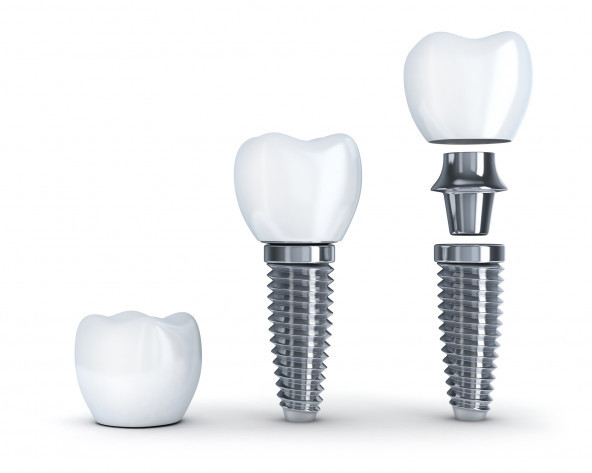How do dental implants work?
First of all:
What is a dental implant?
A dental implant is a tooth replacement option that can be used instead of dentures or dental bridges/crowns.
The physical implant itself is essentially a fake porcelain tooth, mounted onto a titanium screw which is implanted into the jawbone and gum tissue. Dental implants can be used to replace one tooth or multiple teeth. The titanium screw is used to replace the missing tooth’s roots and act as an artificial root, over time it is fused in place by the surrounding teeth and tissues in the mouth. The fake tooth is constructed in such a way to provide you with a functional, attractive, and durable smile for many years.

Are dental implants right for me?
In general, dental implants may be right for you if you:
Do:
- Have one or more missing teeth
- Have a jawbone that’s reached full growth
- Have adequate bone to secure the implants or are able to have a bone graft
- Have healthy oral tissues
- Have the willingness to commit to a several month process
Don’t:
- Have health conditions that will affect bone healing
- Want dentures – or are unable to wear dentures
- Smoke
Benefits of dental implants:
Dental implants are arguably the best tooth replacement option available these days. They offer a number of benefits over alternate replacement options like dentures or dental bridges/crowns. Dental implants:
- Look natural
- Let you bite and chew naturally
- Support themselves and are more sturdy than bridges or dentures.
- Stimulate jawbone and gums which helps prevent bone loss
- Can replace any number of teeth
- Require no alternate care method like dentures do. Simply brush, floss, and make dental visits as you would for the rest of your teeth.
- Are considered a permanent solution for tooth loss. If cared for properly, they can last a lifetime.
- Have proven to be a safe and effective solution for tooth replacement for a number of decades.
How does a dental implant work/What is the procedure?
Dental implants work by a process known as osseointegration, discovered by Dr. Per-Ingvar Brånemark in the 1960s. Osseointegration is derived from the Greek ‘osteon’ meaning bone, and the Latin ‘integrare’, which means to make whole. It is defined as the structural linkage made at the contact point where human bone and the surface of a synthetic (often titanium), based implant meet.
In osseointegration, human bone cells actually attach to the dental implant. This keeps the dental implant firmly secured in place. As long as the bone (and gums) stays healthy, the implant will remain in place.
The entire process for dental implant treatment can take several months as it is performed in stages, with healing time between each stage.
Before you progress anywhere down the dental implant path, you will need to find out if dental implants are actually right for you (your mouth) by meeting with a dental implant dentist. Your teeth and gums must be in a healthy condition in order for dental implants to work correctly. If you have extensive oral tissue damage due to gum disease (or other factors), you may not be eligible for dental implants. If your mouth is otherwise healthy, you should qualify for the implant procedure.
From there you will undergo a comprehensive dental exam consisting of x-rays and 3D images, and may have dental models made of your teeth and jaw to give the dentist a very clear picture of where to place the implant.
Then the first physical step of the process is a minor operation to remove your damaged tooth (or teeth), and insert the dental implant in place of the missing tooth. This is just the titanium part of the implant, and not the false tooth – instead a dental cap AKA a healing cap, is put over the implant to ensure no debris gets in. Your mouth will then need to heal and allow the bone and gum to grow around the implant. This usually takes 3 – 6 months.
During this procedure you will receive some anesthesia to ensure you experience little to no discomfort. Following the procedure you can expect some soreness, but most patients remark it’s much less painful than what they expected. You can of course take over the counter medication to ease any discomfort you may be feeling.
After a few months, and once the implant is stable, your dentist will remove the healing cap and an abutment is put there in place. The abutment is basically the connection between the dental implant screw and the soon to be inserted fake tooth. Once the abutment is fitted onto the implant, your dentist will take an impression/mould of that area of your jaw. This is done in order to ensure proper sizing, shaping, and colouring, for the crown (false tooth/teeth).
Once the crown has been completed, it is attached to the abutment and dental implant, and once in the perfect position, it is further cemented in place and you’ll be set to enjoy your beautiful new smile!
Dental implants don’t need to be removed to be cleaned. You just treat them like another tooth: brush, floss, and make regular dental visits. Some implant configurations might be a little harder to floss than natural teeth, but that’s about all the difference.
If you think you might be a good candidate for the dental implant procedure, contact us at Morrin Dental for a consultation. We will be able to answer any questions you have and let you know what to expect during the procedure.
